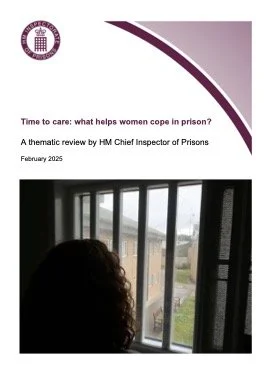By The HM Chief Inspector of Prisons
We undertook this thematic because of our concerns about the very high and increasing levels of self-harm in women’s prisons, the paucity of regimes, the difficulties in enabling visits, the lack of training or support for officers and a failure to help women cope. The focus of this report is on what practical support can be offered by officers and leaders, rather than specific health care interventions. The findings are deeply depressing, with individual jails and the prison service not doing enough to understand the needs of this population or take action to make sure that women receive appropriate support. Between 2013 and 2023, rates of self-harm in women’s jails rose from 1,545 to 5,624 per 1,000 prisoners, and this dramatic increase is indicative of the levels of distress among women in prison. In the surveys carried out during our inspections and the fieldwork for this report, women told us what would help them to cope better. Much of what they describe could be readily achieved with more imagination and determination from both governors and the prison service. In this report we describe a vicious cycle whereby officers are spending so much of their time helping women who are suffering acute crises, that they are unable to provide the less intensive support other prisoners need to prevent them from deteriorating. The staffing position in women’s jails is now much healthier than it has been in recent years and many officers we spoke to wanted to provide prisoners with the support they needed. However, they were unable to complete much of the day-to-day work that is essential to maintain safe, respectful and purposeful jails because they lacked the time or capability to do the job effectively. Many prison officers remain inexperienced and the lack of training they receive is a recurring theme in this report. They were doing their best in often very distressing environments, yet only those working in specialist units received clinical supervision. Officers described the toll it took on them, including feeling traumatised by and eventually desensitised to the shockingly high levels of selfharms and mental illness they witnessed. This report also show that there is a failure to offer opportunities for women to stay in contact with their families, particularly children, for whom many were the primary carers. Phone credit was often not available during women’s first, crucial days in prison, visits were too short, video calls were restricted and visitors themselves were given little support, despite having to travel often long distances with young children. Despite their importance, there was a lack of ambition or creativity in helping women maintain good family ties. We see far more impressive support in the best men’s prisons
London: HM Chief Inspector of Prisons, 2025. 47p.





















